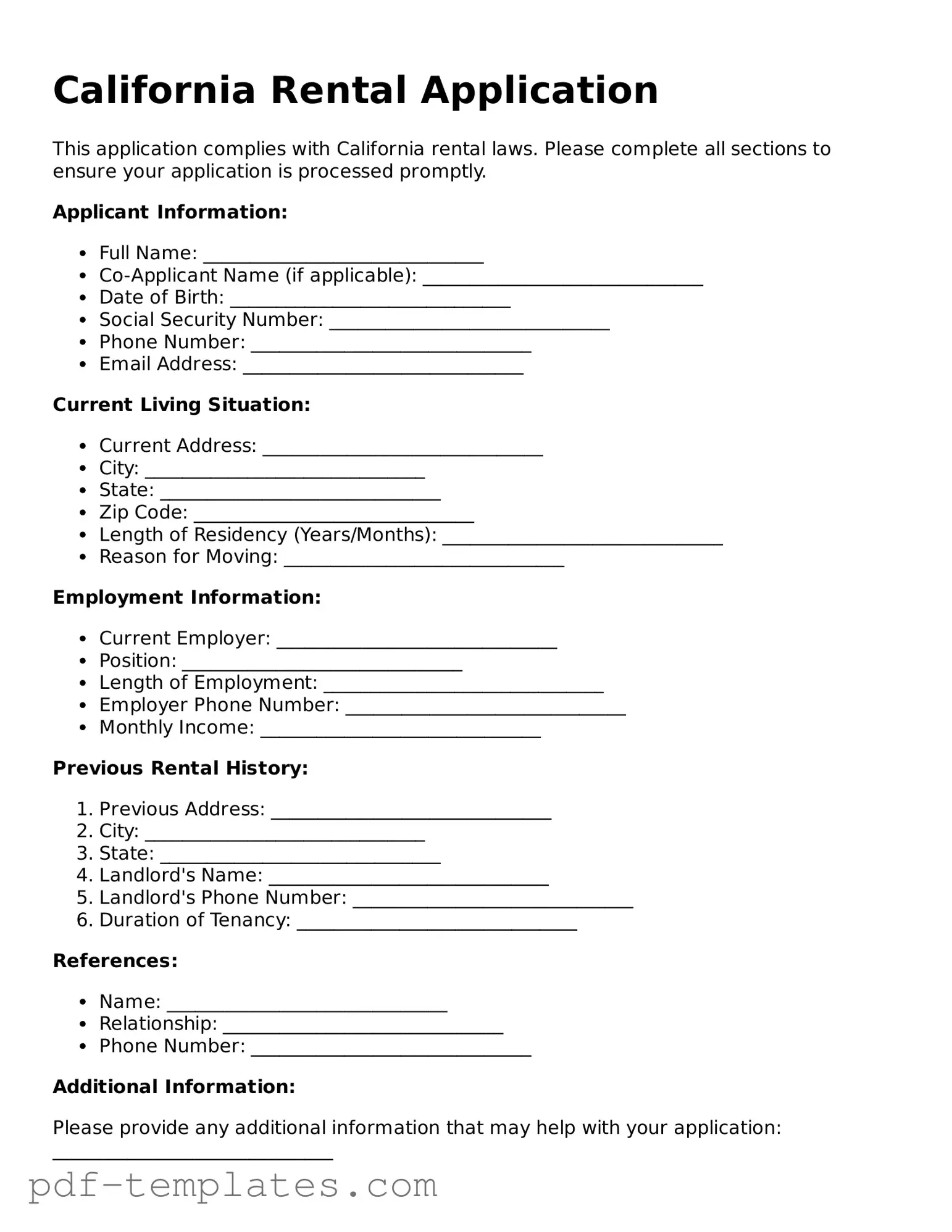The California Rental Application form shares similarities with a Tenant Screening Application. Both documents serve to gather essential information from prospective tenants, such as personal details, rental history, and financial background. The Tenant Screening Application often includes a section for consent to conduct background checks, which is crucial for landlords to assess the suitability of applicants. Like the California Rental Application, this document aims to help landlords make informed decisions about potential tenants.
Another related document is the Lease Agreement. While the Rental Application focuses on gathering information, the Lease Agreement outlines the terms and conditions of the tenancy. It includes details like rent amount, duration of the lease, and rules regarding property use. Both documents are essential in the rental process, with the application serving as a precursor to the lease agreement, ensuring that landlords choose suitable tenants before formalizing the rental relationship.
The Rental History Verification form is also akin to the California Rental Application. This document is used to verify the information provided by applicants regarding their previous rental experiences. Landlords may contact former landlords or property managers to confirm payment history and behavior as tenants. This verification process complements the rental application, helping landlords assess the reliability of potential tenants.
A Credit Report Authorization form is another document that aligns with the California Rental Application. This form allows landlords to obtain a credit report on the applicant, providing insight into their financial responsibility. Just as the rental application collects personal information, this authorization form is crucial for landlords to evaluate an applicant’s creditworthiness, which can significantly influence their decision to rent.
The Employment Verification form is similar in purpose to the Rental Application as well. This document confirms an applicant’s employment status and income, providing landlords with the necessary assurance that the tenant can afford the rent. Both documents work together to paint a complete picture of the applicant’s financial stability and reliability as a tenant.
The Guarantor Application is another related document. When an applicant may not meet certain financial criteria, a guarantor can step in to provide additional security for the landlord. This document collects information about the guarantor, similar to how the Rental Application gathers details about the primary applicant. It ensures that the landlord has a backup plan in case the tenant fails to meet their obligations.
Understanding the various forms used in California, such as the Quitclaim Deed, can help clarify the legal processes involved in property transactions. A California Quitclaim Deed form is a legal document used to transfer interest in real estate from one person to another, typically without any warranties regarding the title of the property. This makes it significantly different from other forms of property deeds that guarantee the status of the property's title. It's often used among family members or to clear up title issues, providing a swift way to deal with property transfers under specific circumstances. For more detailed information, you can refer to All California Forms.
The Pet Application is also comparable to the California Rental Application, particularly for pet-friendly rentals. This document collects information about the pet, including breed, size, and vaccination status. Just like the rental application, it helps landlords assess any potential risks or liabilities associated with allowing pets on their property.
The Move-In Checklist is another important document that complements the Rental Application. While the application focuses on tenant selection, the move-in checklist serves to document the condition of the property before the tenant moves in. This ensures that both parties agree on the state of the rental unit, which can help prevent disputes later on. Both documents play vital roles in establishing clear expectations for the rental agreement.
Lastly, the Rental Agreement Addendum is similar to the California Rental Application in that it addresses specific terms that may not be covered in the standard lease. This could include clauses about additional fees or rules regarding property use. Like the rental application, the addendum is part of the overall rental process, ensuring that both landlords and tenants are on the same page regarding their responsibilities and rights.
